In a world of limited resources and unlimited needs, effective resource allocation has become a crucial aspect of modern society. Whether it’s allocating financial capital, time, energy, or even natural resources, the ability to distribute these limited assets in the most efficient and equitable manner can make a significant difference in achieving desired outcomes.
Resource allocation encompasses various domains, from business and economics to public policy and personal decision-making. This blog explores the principles, strategies, and challenges involved in resource allocation, shedding light on the importance of optimizing allocation processes to maximize productivity, minimize waste, and ultimately foster sustainable growth.
What is Resource Allocation?

Resource allocation refers to the process of distributing and assigning available resources, such as finances, personnel, materials, and time, to various activities and projects within an organization. It involves making strategic decisions to optimize the utilization of resources in order to achieve specific objectives and goals.
Effective resource allocation is essential for businesses to maximize team productivity, minimize waste, and enhance overall efficiency and employee morale. By carefully assessing the needs, priorities, and constraints of different projects or departments, organizations can allocate resources in a balanced and strategic manner. This ensures that resources are allocated where they are most needed and can generate the highest return on investment.
According to a study by McKinsey, the top management lever for driving growth, as identified by 83% of senior executives, is resource allocation. Additionally, the study found that companies that reallocate more resources earn, on average, 30 percent higher total returns to shareholders annually.
Why Is It Important to Allocate Resources Effectively?
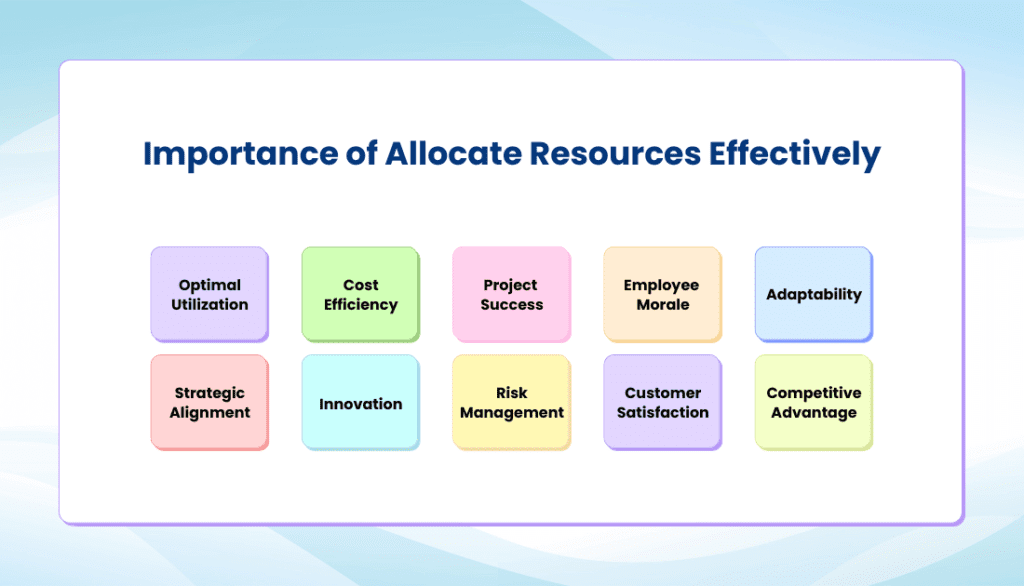
Allocating resources effectively is crucial for several reasons:
Optimal Utilization: Effective resource allocation ensures that all available resources, including finances, personnel, time, and equipment, are used to their fullest potential. This maximizes productivity and minimizes waste.
Cost Efficiency: Proper allocation helps minimize unnecessary spending. When resources are managed efficiently, costs associated with excess or redundant resources can be reduced, leading to better financial management.
Project Success: In project management, allocating resources according to project requirements ensures that tasks are completed on time and within budget. This increases the likelihood of project success and meeting client expectations.
Employee Morale: Efficient resource allocation leads to well-organized work processes. Employees are more likely to be motivated and engaged when they have the tools and support they need to complete tasks effectively.
Adaptability: Effective allocation allows organizations to respond to changing circumstances, such as shifts in demand or unexpected challenges. Flexible resource allocation helps maintain stability and competitiveness.
Strategic Alignment: Allocating resources in line with organizational goals and priorities ensures that the company is moving in the right direction. This strategic alignment enhances overall performance and long-term growth.
Innovation: Proper resource allocation supports research, development, and innovation initiatives. By dedicating resources to these areas, organizations can stay competitive and drive new ideas.
Risk Management: Effective allocation accounts for potential risks and uncertainties. Adequate contingency planning helps mitigate the impact of unforeseen events.
Customer Satisfaction: Allocating resources to customer-facing activities, such as customer support and quality assurance, enhances the overall customer experience, leading to higher satisfaction levels.
Competitive Advantage: Organizations that allocate resources wisely can react quickly to market changes, stay ahead of competitors, and seize opportunities as they arise.
In essence, effective resource allocation contributes to operational excellence, financial stability, and the ability to adapt and thrive in a dynamic business environment
Famous Businesses with Successful Resource Allocation System
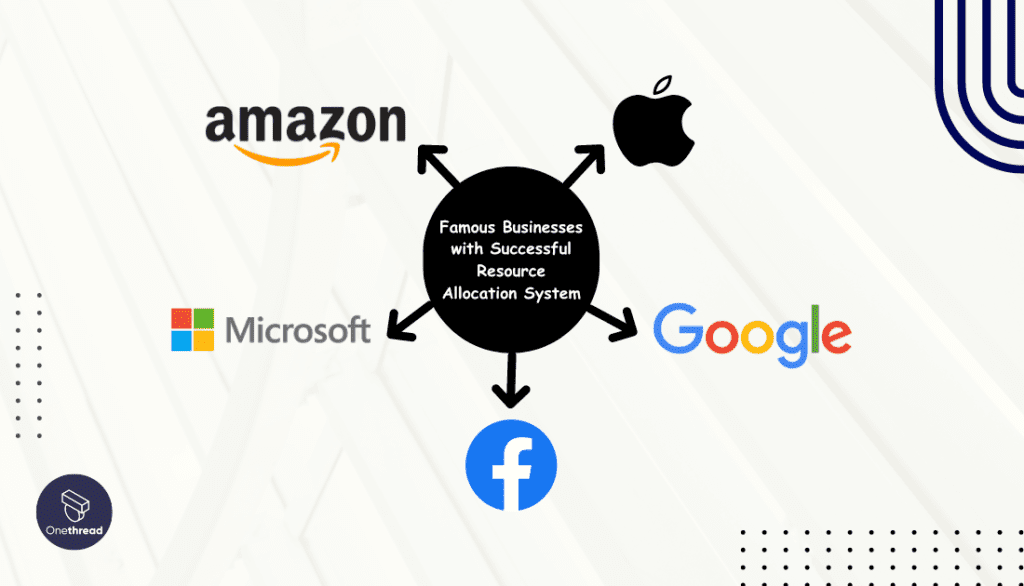
Big giants are using successful resource allocation systems to make more revenue. If your resource allocation system is not good enough, you should give things a second thought. Take these brands as examples.
Amazon: Masterful Resource Allocation
Amazon, a globally renowned e-commerce behemoth, has demonstrated unparalleled prowess in deftly distributing resources across its diverse business units. Notably, the company has made substantial investments in its cloud computing division, Amazon Web Services (AWS), solidifying its position as an unrivaled force in the realm of cloud computing platforms. This astute resource allocation has played a pivotal role in propelling Amazon to achieve remarkable profitability, boasting a profit margin of 11.8% in 2022.
Apple
Apple, an epitome of innovation, has showcased extraordinary mastery in allocating resources to fuel its product development and marketing teams. As a result, the company has triumphantly launched a myriad of groundbreaking products, including the iconic iPhone, enhanced with upcoming iOS 18 features, iPad, and MacBook.. With resource allocation at the core of its strategy, Apple achieved a staggering profit margin of 27.8% in 2022.
Microsoft
Microsoft, a venerable software corporation, has exemplified unrivaled expertise in resource allocation, specifically directed toward empowering its dedicated research and development team. This judicious allocation has been instrumental in nurturing a rich portfolio of triumphant software products, including the ubiquitous Windows, Office suite, and Xbox. In 2022, Microsoft flourished with an exemplary profit margin of 30.5%.
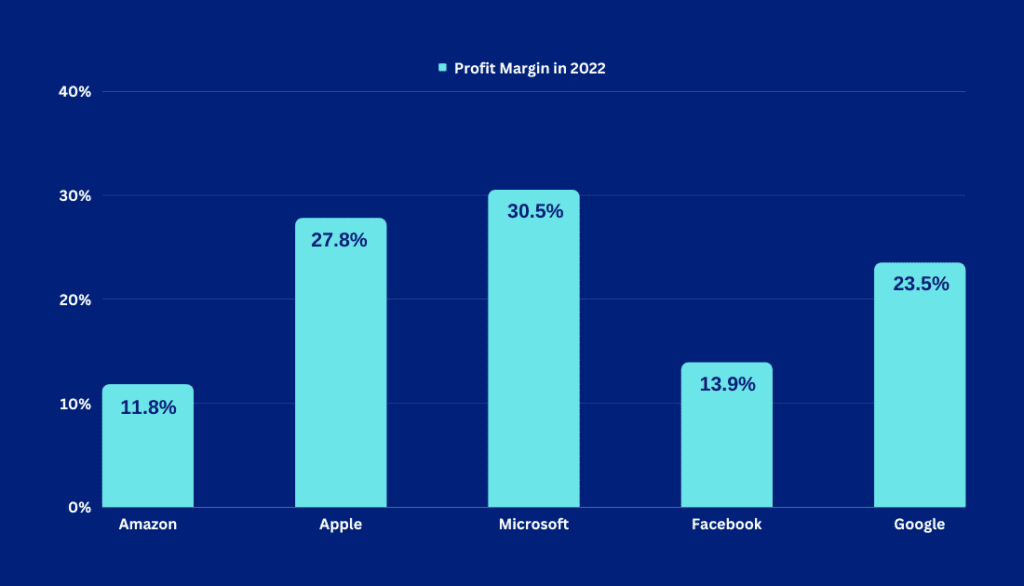
Google, a titan in the technology realm, has demonstrated sheer brilliance in allocating resources, particularly within its advertising business domain. This strategic allocation has propelled the company to unrivaled heights, solidifying its position as the preeminent online advertising platform worldwide. In 2022, Google’s resource allocation acumen translated into an impressive profit margin of 23.5%.
Facebook, a trailblazer in the realm of social media, has wielded resource allocation wizardry to propel its user growth and engagement teams. This deft allocation has propelled the company to secure its status as the unrivaled champion of social media platforms globally. In 2022, Facebook’s resource allocation prowess manifested in a commendable profit margin of 13.9%.
But Here’s the Thing You Should Know….
Manual Resource Allocation Vs Software-Based Resource Allocation
While you can’t deny the benefits of a resource allocation system, you also need to know that there are resource allocation systems THAT FAIL. And what successful businesses have in common is — they use resource management software like Onethread to get things done.
So, before going manual, you need to know the difference between manual resource allocation and software-based resource allocation:
Criteria | Manual Resource Allocation | Software-Based Resource Allocation |
Flexibility | Offers flexibility to adjust resources on the fly, especially in response to unexpected changes or dynamic project requirements. | Provides limited flexibility as it follows predefined algorithms and rules for resource allocation, making it less adaptable to real-time changes |
Efficiency | Can be time-consuming and prone to errors, requiring manual effort for tracking and updating resource allocation information. | Offers automation, saving time and reducing errors associated with manual processes. Provides a centralized platform for resource tracking and management. |
Resource Optimization | Relies on human judgment and may lack comprehensive insights into resource availability, workload, and dependencies, potentially leading to suboptimal allocation decisions. | Utilizes algorithms and data analysis to optimize resource allocation based on resource availability, workload, dependencies, and other factors, leading to more optimized allocation decisions. |
Scalability | Works well for smaller projects with limited resources and simpler dependencies. | Better suited for larger projects with numerous resources, complex dependencies, and higher scalability requirements. |
Collaboration | Encourages collaboration and communication among team members as they actively participate in the resource allocation process. | Supports collaboration by providing a centralized platform for team members to view and access resource allocation information. Allows for better visibility and coordination. |
Reporting and Insights | May lack comprehensive reporting capabilities, requiring manual compilation and analysis of resource allocation data. | Provides robust reporting and analytics features, generating insights and performance metrics related to resource allocation. Enables data-driven decision-making. |
Cost | Generally, lower cost as it does not require additional software investments. | Involves costs associated with acquiring, implementing, and maintaining project management software. However, the benefits of improved efficiency and optimized resource allocation can outweigh the costs. |
Still Thinking of Going Manual in Resource Allocation?

Here are a Few Things to Learn if you are still thinking of going manual:
- Manual resource allocation systems face challenges due to the lack of real-time updates, which can result in outdated information on resource availability and utilization.
- The time-consuming nature of manual resource allocation processes can hinder efficiency, especially when dealing with larger projects or numerous resources.
- Tracking changes and updates to resource allocation manually can be difficult, leading to potential inconsistencies and miscommunications among team members.
- Limited visibility is a common challenge in manual resource allocation systems, making it hard to gain a comprehensive overview of resource allocation across different projects or teams.
- Manual resource allocation may not fully optimize resource allocation decisions, as it relies on human judgment and may not consider factors like workload, task dependencies, or skill matching.
- Coordinating resource allocation across multiple projects can be complex in a manual system, requiring diligent effort to balance resource demands and prioritize tasks effectively.
- Manual resource allocation systems often lack robust data analysis capabilities, making it challenging to analyze resource utilization, identify bottlenecks, or make data-driven decisions.
- The increased risk of errors is a concern in manual resource allocation, as human error can lead to issues such as double-booking resources or inaccurately estimating resource needs.
- Limited collaboration and communication features in manual resource allocation systems can hinder active participation and effective communication among team members.
- Scalability limitations can arise with manual resource allocation systems, particularly when dealing with larger projects or organizations, as manual processes become increasingly difficult to manage efficiently.
How Can Onethread Help You

While Onethread is not a Resource allocation and management software at its core, its versatile feature list can be customized for the following use cases. Most of these features are fit for allocating and managing human resources:
Centralized Resource Database:
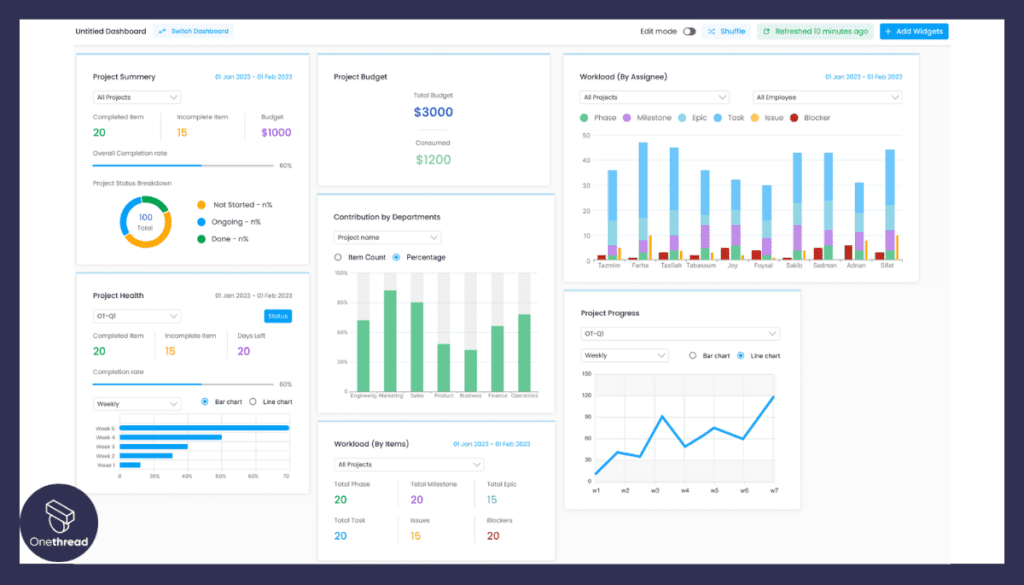
Onethread is a task management software that provides a centralized database where you can store and manage all your resources in one place. This allows for easy access to resource information, including availability, skills, roles, and experience.
Real-Time Resource Visibility:
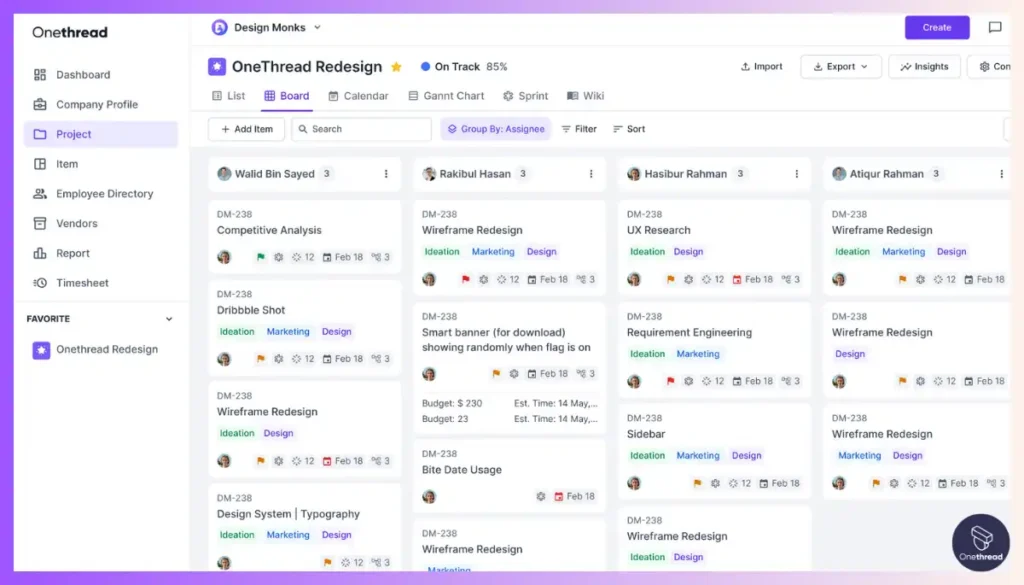
Onethread offers real-time visibility into resource availability and utilization. You can quickly see which resources are currently assigned to tasks or projects and their availability for future assignments.
Efficient Resource Allocation:
Onethread simplifies the resource allocation process by providing intuitive features and tools. You can easily search for resources based on criteria such as skills or availability, allowing you to allocate resources efficiently and effectively.
Conflict Management:
Onethread helps in identifying and resolving resource conflicts by highlighting overlapping assignments or scheduling conflicts. This enables you to make adjustments and ensure optimal resource allocation without overbooking or underutilizing resources.
Skills and Experience Matching:
With Onethread, you can easily match the required skills and experience for specific tasks or projects with the capabilities of your resources. This ensures that the right resources with the necessary expertise are allocated to the appropriate assignments.
Resource Tracking and Reporting:
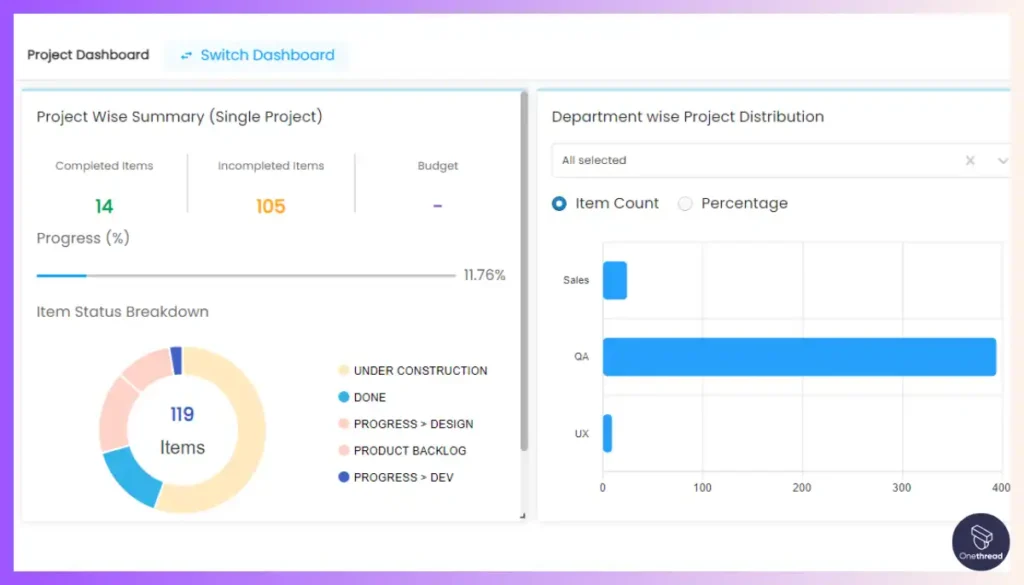
Onethread enables you to track resource utilization, monitor progress, and generate reports on resource allocation. This provides valuable insights into resource performance, balance in workload management, and helps in making data-driven decisions for future resource allocation.
Resource Request Management:
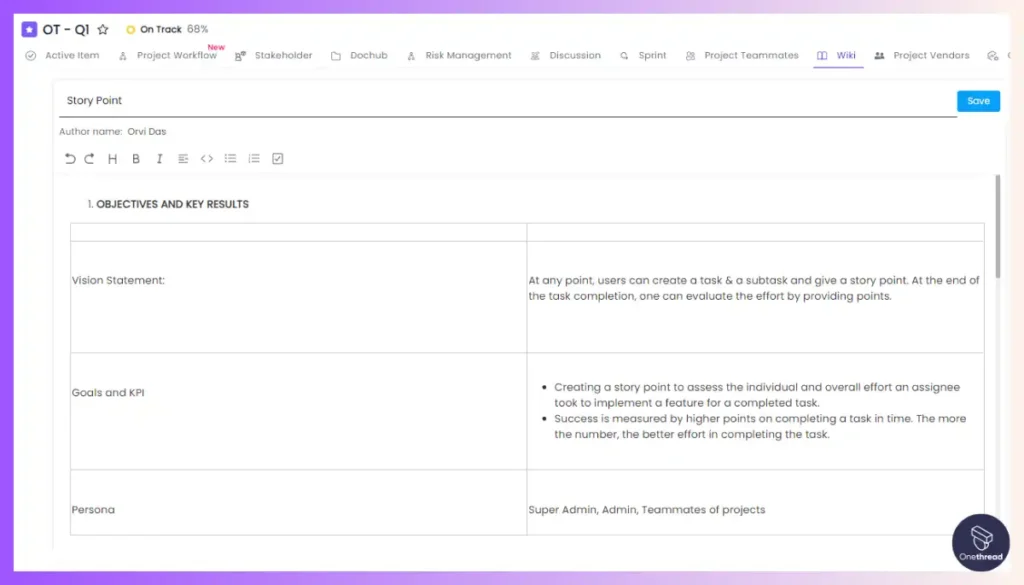
Onethread allows you to streamline the process of requesting resources with proper documentation and wiki feature. Project managers or team leads can submit resource requests directly within the software, specifying the required skills, duration, and priority. This centralized request management ensures a systematic approach to resource allocation.
Capacity Planning:
Onethread offers capacity planning features that help you assess resource availability against project demands. With the ability to view resource capacity and workload, you can identify potential bottlenecks, redistribute resources if needed, and proactively address any resource constraints.
Historical Data Analysis:
Onethread provides access to historical resource allocation data. By analyzing past resource allocation patterns and outcomes, you can identify trends, gain insights into resource utilization, and make data-informed decisions for future projects.
Best Practices to Master Resource Allocation
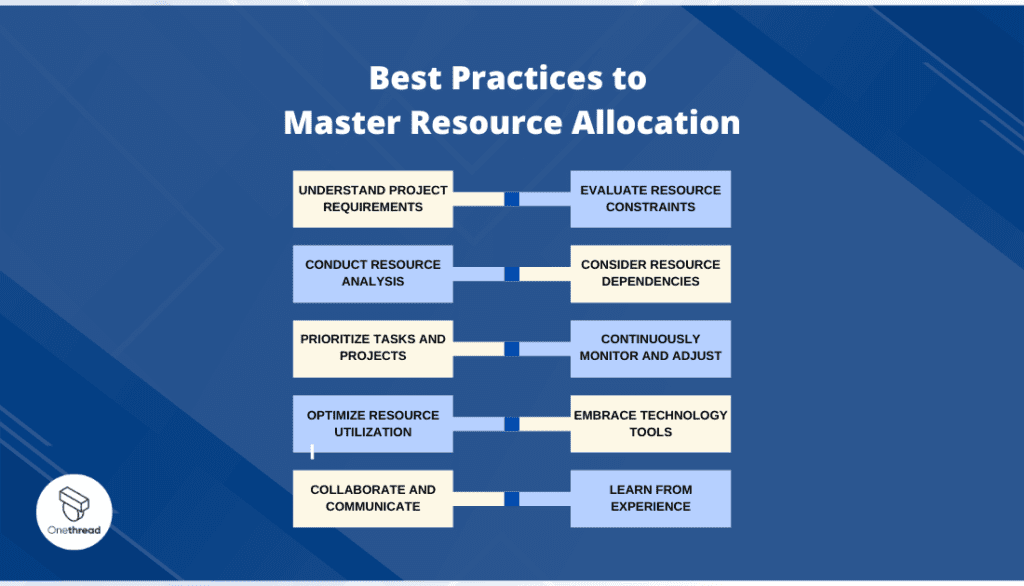
To master resource allocation effectively, here are some best practices to follow
Understand Project Requirements: Gain a deep understanding of project requirements, objectives, and deliverables. Clearly define the scope and identify the key resources needed to accomplish the project goals.
Conduct Resource Analysis: Conduct a comprehensive analysis of available resources, including their skills, expertise, availability, and capacity. This analysis will help in aligning the right resources with the project requirements.
Prioritize Tasks and Projects: Prioritize tasks and projects based on their importance, deadlines, and potential impact on overall business goals. Allocate resources accordingly, giving priority to critical tasks that align with strategic objectives.
Optimize Resource Utilization: Strive to optimize resource utilization by ensuring a balanced workload distribution. Avoid overburdening resources or leaving them underutilized. Regularly review resource allocation to identify opportunities for optimization.
Collaborate and Communicate: Foster collaboration and open communication among stakeholders involved in resource allocation. Encourage input from team members, project managers, and resource managers to ensure efficient decision-making and resource allocation. Go for a communication tool if needed.
Evaluate Resource Constraints: Identify any resource constraints such as limited availability, specific skills required, or budget limitations. Proactively address these constraints by exploring alternative solutions, such as outsourcing custom software solutions, digital marketing, or accounting services, cross-training, or hiring additional resources if necessary.
Consider Resource Dependencies: Take into account resource dependencies and potential conflicts. Assess the impact of resource allocation decisions on other projects or tasks. Address any conflicts through effective coordination and negotiation among project teams.
Continuously Monitor and Adjust: Regularly monitor resource allocation and its impact on project progress and outcomes. Collect feedback, track resource performance, and make necessary adjustments based on changing project needs or unforeseen circumstances.
Embrace Technology Tools: Leverage resource management software or project management tools that offer automation, real-time visibility, and reporting capabilities. These tools can streamline resource allocation processes, improve accuracy, and facilitate data-driven decision-making.
Learn from Experience: Continuously learn from past projects and experiences. Analyze resource allocation strategies, outcomes, and lessons learned. Apply those insights to refine future resource allocation decisions and improve overall resource management practices.
Wrapping Up!
In summary, resource allocation is a complex and dynamic process that requires careful planning, informed decision-making, and continuous evaluation. When done right, it can unlock the full potential of an organization, maximize productivity, and drive sustainable growth. By prioritizing resource allocation as a strategic function, organizations can position themselves for success in an increasingly competitive business landscape.
